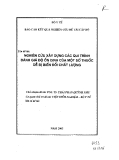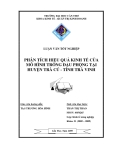Original article
Modelling branchiness of Corsican pine with mixed-effect models (Pinus nigra Arnold ssp. laricio (Poiret) Maire)
Céline Meredieu
Francis Colinb Jean-Christophe Hervéc
aDivision écosystèmes forestiers et paysage, Cemagref, domaine des Barres, 45290 Nogent-sur-Vernisson, France bUnité croissance, production et qualité du bois, Inra Nancy, 54280 Champenoux cedex, France. cÉquipe dynamique des systèmes forestiers, Engref/Inra, 14, rue Girardet, 54042 Nancy cedex, France
(Received 20 May 1997; accepted 15 December 1997)
Abstract - In order to predict the influence of silvicultural practices on knottiness and canopy struc- ture, models were constructed to predict branch characteristics of Corsican Pine (Pinus nigra Arnold ssp. laricio (Poiret) Maire var. corsicana) from usual tree measurements. Thirty-six trees were sampled from a broad range of age, stand density and site index. Mixed models were fitted on branch length and on branch angle after a linearization procedure. A segmented second order polynomial model was chosen for the diameter profile. Nevertheless, this model seemed difficult to be transformed for fitting mixed models, but a global model was however satisfactory. For real- istic simulations with these models, we generated simulated correlated residuals of angle and diameter in order to maintain the negative link between angle and diameter of a branch. The mixed model method provides an improvement of the fit by accounting for inter-tree differences and/or intra-tree similarities and also an improvement of the simulation. The possibility to fit mixed- effect non-linear models allows a great number of models. (© Inra/Elsevier, Paris.)
branchiness / Pinus nigra ssp. laricio / modelling / mixed model / simulation
Résumé - Modélisation de la branchaison du pin laricio à l’aide de modèles à effets mixtes (Pinus nigra Arnold ssp. laricio (Poiret) Maire). Dans le but final de prévoir l’influence de la sylviculture sur la nodosité et le couvert, des modèles de prédiction des principales caractéristiques des branches à partir des données dendrométriques usuelles ont été construits. Trente-six pins lari- cio (Pinus nigra Arnold ssp. laricio (Poiret) Maire var. corsicana) ont été décrits. Les modèles
* Correspondence and reprints Inra, Unité de Recherches forestières Méditerranéennes, avenue Vivaldi, 84000 Avignon France. E-mail: meredieu@avignon.inra.fr
mixtes ont été ajustés sur les données de longueur de branche et après linéarisation sur les don- nées d’angle de branche. Pour les diamètres, nous avons choisi un modèle polynomial de second ordre segmenté. Cependant, la méthode d’ajustement par la procédure de modèle mixte n’a pas pu être utilisée pour ce modèle complexe d’ajustement. Néanmoins un modèle global satisfaisant pour l’ensemble des arbres a pu être trouvé. Pour une simulation plus réaliste des angles et des dia- mètres des branches, nous avons généré des résidus corrélés afin de tenir compte de la liaison néga- tive qui existe entre angle et diamètre d’une branche. En conclusion, les modèles mixtes améliorent les ajustements en tenant compte des différences et/ou des similarités inter- et intra-arbre. La possibilité d’ajuster des modèles non linéaires à effets mixtes permet d’augmenter le choix des modèles. À partir de ces modèles les simulations sont améliorées. (© Inra/Elsevier, Paris.)
branchaison / Pinus nigra ssp. laricio / modélisation / modèle mixte / simulation
acute is the angle, the more important is the volume of wood affected by the knot. The capacity to predict these branch char- acteristics is therefore the key to the suc- cessful linking of silvicultural regimes and wood product quality [21]. Concerning length, extension and inclination of branch this information is interesting for repre- sentation of trees in the stand and of the canopy structure [5]. The branch length is important for the foliage display and thus influence tree growth [24]. The branch growth depends on the apical con- trol of the main stem. It decreases from the top of the tree to the base and from the inside of the tree to the outside [11].
Both silviculturists and wood scientists need management tools that integrate both growth and wood quality information in order to predict the influence of site qual- ity and silvicultural regime on individual tree growth, on stand yield, on stand struc- ture and on wood quality. Our project con- sists in setting up interconnected sub-mod- els that range from growth models to saw quality simulators. The quality is defined mainly in terms of wood density, mechan- ical properties and knottiness. Directly linked with this latter property, the crown is considered to be the most sensitive com- ponent of a tree under direct influence of genetics and of surrounding growth con- ditions [10, 31]. It is considered as a link between the internal structure of the stem, the knottiness and the branch growth [4].
The branching of a tree must be speci- fied in terms of vertical profiles of branch number per annual shoot, status: living or dead, angle and diameter at insertion on the trunk, length, lateral extension and inclination of each whorl branch along the stem. The first four variables are consid- ered as inputs into wood quality simula- tors. These simulators have a prediction component of knot shape (for instance Leban and Duchanois [14]). This shape is predictable if branch angle and diameter as well as bole radius are available. It has been shown for instance that the more
1. INTRODUCTION
Numerous relationships between stem and branches have been established on other coniferous species, for instance: rela- tionships between diameter at breast height (DBH) and height, and the diameter of the thickest branch of Pinus sylvestris or of Picea abies [8], relationships between DBH and the diameter of the thickest branch at 70 % of the height (Picea abies, [9]), DBH and height and mean branch diameter at the base of the living crown [ 19]. Mitchell [23] observed that for Picea glauca the length of whorl branch at the largest extension of the crown is related with the length between the tree top and the branch insertion. Considering these previous results we planned to predict the vertical profiles of branch characteristics based on the stem attributes (such as DBH,
height, etc.). In order to fit these profiles, methods have been proposed [4] but they still need to be improved to clearly dis- tinguish different levels of variability and between-tree variability.
Therefore, the aim of this paper is to propose the use of mixed models which improves both modelling and simulation of the vertical profiles of angle, diameter and length of branch for Corsican pine.
2. MATERIALS AND METHODS
2.1. Structural development
of Corsican pine
branches directly inserted on the main stem, the primary branches.
2.3. Variables
This study concerns Corsican pine (Pinus nigra Arnold ssp. laricio (Poiret) Maire var. corsicana). It is a fast growing conifer with good wood quality and a straight stem. The stem and the branches are monopodial with a strong apical control. Branch and stem elon- gation are annual, and each annual shoot con- stitutes one growth unit (GU). Lateral branch- ing usually occurs I year after bud formation (proleptic branching). Branches are located only at the top of each annual growth unit, clus- tered in whorls. There are no inter-whorl branches.
2.2. Sampling
Two kinds of variables were used: branch descriptors and whole tree descriptors (table II). The latter were the standard tree measure- ments, crown heights and combination of vari- ables: diameter at breast height (DBH) (in cm, measured to the nearest 5 mm); total height (TH) of the stem (in m, to the nearest 5 cm); height to the lowest living branch (HLLB) (in m, to the nearest 5 cm); height to the lowest living whorl (HLLW) (in m, to the nearest 5 cm) where at least three quarters of branches were living; crown length 1 (CL): CL = TH - HLLB (in m); crown length 2 (HLLWA): HLLWA = TH - HLLW (in m); length between the lowest living whorl and the lowest living branch (DIFF) (in m); crown ratio 1 (CR): CR = (TH - HLLW)/TH; crown ratio 3 (CR3): CR3 = (TH - HLLB)/TH; crown ratio 2 (CR2): CR2 = (CR + CR3)/2; based on the bud-scale scars and whorl, each annual elongation or growth unit (GU) was identified by its rank recorded from the tree top: GU = I is the youngest growth unit elongated in year y, GU = 2 is the growth unit elongated in y - 1, etc.; length of each annual growth unit
Twelve plantations of Corsican pine located in the region ’Centre’ (France) were selected in order to investigate a broad range of age, indi- vidual growing space and site index (table I). We tried to select only trees from the variety corsicana. Artificially pruned plantations and unhealthy plantations were avoided. In each plantation, a 0.3-ha plot was installed. Girth at breast height of all trees was measured in order to select three trees of different social status: one dominated (from the lower girth class), one medium (with a girth near the mean girth) and one dominant (from the higher girth class). Trees with very serious crown defects and with forked stems were excluded. Thirty- six trees were felled and measured in 1995. Data describing crown size and development were collected, based on the analysis of all the
2.4.1. First step: establishment of a global fixed-effect model
First, we modelled the variation of each variable along each stem with individual equa- tions (one per tree) [22] as:
(GUlength) measured between two successive whorls (in cm, to the nearest 5 cm); distance from the apex (DFA): absolute distance from each whorl (top of the growth unit) to the top of the stem (in m, to the nearest 5 cm); age (A) of the tree based on the number of whorls and checked by counting the annual rings on the stump section after felling (in years).
where Yij represents for example the branch angle, Xij the independent variable (i.e. the pre- dictors), i denotes the ith tree, j the jth annual growth unit, &thetas;i the model parameters specific to the ith tree and ϵi,j the within-tree residual vari- ation.
Then, linear regressions were carried out in order to analyse the variability of the param- eters &thetas;i in relation to the whole tree descrip- tors:
For each branch, we measured: branch diameter over bark (BD) (in mm, to the nearest mm, at a distance from the bole that was approximately equal to one branch diameter, on the horizontal axis; dead and living branches are measured); branch insertion angle (BA) (in grad, to the nearest 5 grad) between the axis of the branch and the axis of the main stem (dead and living branches are measured); branch length (BL) (in cm, to the nearest I cm): distance between the top of the branch and its branch insertion (living branches are measured).
2.4. Statistical analysis
where &thetas;ik denotes the kth parameter in the vec- tor &thetas;i. ψk denotes the global parameters com- mon to all sampled trees and ηik is a random error representing unexplained between-tree variations. It may happen that some parame- ters &thetas;ik do not have any clear relationship with the whole tree descriptors; in this case, equation (2) above simply becomes: &thetas;ik = μk + ηik where μk is the mean of &thetas;ik over the trees.
The variables to be predicted are BL, BA and BD, as functions of DFA, GU and/or GUlength and also whole tree descriptors. The analyses were carried out following three main steps.
where &thetas; is the mean of &thetas;i over the trees and δi is the ith tree individual deviation from &thetas;, with mean zero and variance-covariance matrix B.
Returning to Yij, this yields:
Finally, we transformed the individual mod- els into a global model by progressively replac- ing the &thetas;i parameters in (1) by their predictions (2). We obtained fixed-effect models of the following form:
In such models, the unexplained between-
tree variations ηik in (2) are neglected.
where (1) is explained variation (fixed effects), (2) is the between-tree random deviation (tree effects), and (3) is the within-tree residual vari- ation.
2.4.2. Second step: linearization of the global model, if necessary
In general, the tree vector parameters &thetas;i may also be a linear function of tree variables, and some parameters in &thetas;i may have no ran- dom variation. The general mixed-effect model is then:
where &thetas; is a fixed-effect parameter vector, Xij is the fixed-effect variables, bi is the vector of (tree) random effects, Zij is the vector of vari- ables associated with the random effects, ϵij is the residual within-tree random variation. Fur- thermore bi and ϵij are supposed normally dis- tributed, independently of each others:
In order to change the global models into mixed models, we had to transform the non- linear models into linear ones. Several methods have been proposed to fit non-linear mixed models (Lindstrom and Bates [16]; Wolfinger [32]; and others: see Gregoire and Schaben- berger [7]). One of the simplest due to Beal and Sheiner [2] and used by Gregoire and Sch- abenberger [7] is to approximate the marginal distribution of the response vector by expand- ing the global model in a first-order Taylor series; it was adopted in the present study.
2.4.3. Third step: fitting of mixed
linear model
where B is the variance-covariance matrix of random effects and σ2 the within-tree residual variance.
The unknown parameters (fixed-effect parameter &thetas;, variances and covariances of ran- dom effects and residual variance σ2) are esti- mated using restricted maximum likelihood [13].
In this step, we improved the linear fixed- effect model by taking into account the vari- ability between trees due to the mixed model. The mixed linear model (with both fixed and random effects) is a generalization of the standard linear model; the generalization being that it is possible to analyse data with several sources of variation and especially within- and between-tree variations. For a detailed descrip- tion of the theory, refer to Laird and Ware [13] and Diggle et al. [6].
Suppose for example that a variable Yij (for instance branch length) is linearly linked to others variables Xij within each tree:
where ϵ’ij is the within-tree unexplained vari- ation and &thetas;i is the vector of parameters, spe- cific of the ith tree. Suppose that &thetas;i varies from tree to tree independently at random, so that, when looking at different trees, one can write:
One of the criteria to measure the goodness of fit is the Akaike information criterion (AIC) which permits us to compare models with the same fixed effects but different variance struc- ture. AIC is computed as: AIC = &jadnr; + 2 p where &jadnr; is twice the negative log-likelihood evaluated at the maximum likelihood estimates (or restricted maximum likelihood estimates) and p is the number of estimated parameters. A procedure was designed especially for fitting mixed linear model in SAS/STAT. This function called PROC MIXED has been avail- able in release 6.07 [17, 28].
2.5. Generation of values from
After improving each model and its fitting with our data, the last stage was to include them in a growth simulator. With the charac- teristics of simulated trees given by the growth simulator, our equations permit us to simulate their branchiness. For each equation con- structed with mixed model procedure, or in order to take into account the correlation between residuals of different models, we had to generate values of parameters (for example, γ1, γ2) from normal distribution with mean 0 and given variance-covariance matrix V:
We first generated a random vector g from a normal distribution with mean 0 and identity variance-covariance matrix, using the SAS function Normal [28]. g is then transformed to a N (0, V) by multiplying it by a lower triangu- lar matrix L such that LLt = V (Cholevski decomposition of V).
3. RESULTS
normal distribution with mean 0 and given variance-covariance matrix
the apex (DFA) as the independent vari- able:
where a1i and a2i are the individual param- eters for each tree. The R-square ranged between 0.93 and 0.99 and the residual standard deviation ranged between 20 and 55 cm depending on trees. Then, we anal- ysed the variability of the parameters a1i and a2i in relation to the whole tree descriptors. DBH had a linear relationship with a1i (R2 = 0.30). Other tree descrip- tors, such as crown variables, did not show any relationship with the individuals parameters. This led to the following global model with DFA, DFA2 and DFA.DBH as independent variables (fitted to 1782 branches):
3.1. Branch length 3.1.1. Construction of a linear mixed
model
First, for each tree, we fitted individ- ual linear models with the distance from
The R-square was equal to 0.835 and the residual standard deviation was equal
For diameter and angle, dead and living branches were taken into account in the fit of individual profiles. In fact for each tree, the scatter of diameter and angle data is continuous at the level where the two kinds of branches overlap. Only living branches were taken into account for branch length. For all the following anal- yses, we removed branches with a partic- ularly acute angle (ramicorn branches) (i.e. a total of seven branches in sampled trees) and branches with a diameter of less than half of the maximum diameter per whorl (figure 1). In term of knottiness, the influence of these thin branches can be neglected.
to 43 cm. This fixed-effect model has been improved by taking into account the vari- ability between trees due to the mixed lin- ear model. This was carried out here by adding a random tree component to some or all parameters a0, a1, a2, a3. Among several attempts of different random effect combinations, we chose the model with the highest AIC, which included random effects for the intercept, DFA, DFA2:
files of trees. For each tree, the values of α0i, α1i and α2i were generated from a trivariate normal distribution with mean 0 and variance-covariance matrix given by the fit of model (4). Then for each branch in a tree, a random residual was simulated from a normal distribution with mean zero and variance equal to the resid- ual variance of the model (4). Figure 2b shows an example of a simulated branch length profile from growth characteristics (DFA, DBH, number of branches per whorl).
3.2. Branch angle and diameter
3.2.1. The branch angle model: a non-linear mixed model
3.1.2. Simulation of branch length
profile
Parameter estimates of fixed effects (A0, A1, A2, A3), variances/covariances of random effects (α0i, α1i, α2i) are pro- vided in table III. The standard deviation was only 34.3 cm. Figure 2a shows how the mixed linear model fits the data for one tree.
To predict the vertical trend of angle for both dead and living branches, we used the number of annual growth units counted downwards from the top of the stem (vari- able GU) as independent variable. Accord- ing to Meredieu and Colin [22], we fitted the following non-linear individual model:
The estimates of the covariance param- eters allowed us to simulate different pro-
where b 1i and b2i are parameters con- strained to be positive, and c is a constant (c=51).
where the derivative expressions mean the partial derivative with respect to the indi- cated parameter, evaluated at the guessed values. We have:
and rearranging, this yields:
We did not obtain good relationships between individual parameters and global tree characteristics. Nevertheless, it was important to characterize both inter- individual and intra-individual variations adequately in order to permit valid simu- lations. For this reason, we adopted the following mixed-effect model:
Model (8) is a linear mixed model where the non-linear response has been replaced by an approximated linear model.
To fit this non-linear mixed model we approximated the marginal distribution of the response vector by expanding our model (6) in a first-order Taylor series. A first-order Taylor expansion of our model, around guessed values b10 and b20 (obtained by fitting the fixed-effect ver- sion of model (6)), gave the following approximate linear model (7):
joint value ξ which is the location of the estimated thickest branch:
where d0, d1, d2, d3 and d4 are positive constrained parameters and ξ=-d1/(2 d2).
The approximation is better if the guessed values b10 and b20 are chosen near the true unknown values b1 and b2. We used esti- mates obtained by fitting the fixed-effect version of model (6). Then we estimated the parameters of the new linear mixed- effect model. New estimates were obtained. If necessary we repeated this step with the updated estimates as guessed values until the change in the likelihood was insignificant.
This model was fitted independently for each tree [22]. Then we tried to con- struct a single global model. First, d4 was fixed at 1. This parameter was therefore transformed into a constant in further ana- lyses. Then, we analysed the variability of the parameters ξ, d1 and d3 in relation to the whole tree descriptors. Among var- ious combinations of whole-tree descrip- tors, the best fits were given by:
3.2.2. Construction of the branch
diameter model: a fixed-effect model
The fixed effect version of (8) was fit- ted to benchmark the anticipated improve- ment offered by the inclusion of the ran- dom parameters in the model. When (8) was fitted with only fixed effects, AIC =-17003 and when it was fitted with random and fixed effects, AIC =-16535. For this latter model σ2 = 118.2 and all the parameters were clearly significant (table IV). The branch angle profile pre- dicted by this model is shown by a solid line in figure 3 and the deficiencies of the fixed-effect version of the model become apparent.
Consequently, we deduced from ξ and d1 one relation for d2. We formed a global model (12) which was estimated for all trees.
According to Colin and Houllier [3] we chose for the diameter profile a segmented second order polynomial model with a
we had to take into account the link between diameter and angle within a tree: globally, the thickest branches had an acute angle whereas the thinner branches had an open angle. Although a part of this link is taken into account in the models above through the common or linked vari- ables of each model, it remains a rela- tionship between the unexplained within- tree variations of diameter and angle (figure 5).
Formally, for a branch j in a tree i, we have to simulate the branch angle BAij and the branch diameter BDij according to:
The parameter values and their stan- dard errors were estimated as follows in table V (statistics of fit for 4 303 obser- vations on 36 trees: root mean square error (RMSE) = 6.5 mm). Figure 4 shows how the model fits the data for two trees.
3.2.3. Joint simulation of branch
length and branch angle profiles
If the linearization of this complex model was also possible using the same method as for branch angle, the mixed model introduced numerous fixed and ran- dom effects which could not be dealt with classical statistical package (SAS statis- tical package).
where fA is the angle model (8), fD the diameter model, BA and dD the fixed-effect parameters for angle and diameter, respec- tively, βi is the vector of random tree effects for angle (to be generated from a bivariate normal distribution with vari- ance-covariance matrix as given in table IV, and ϵAij and ϵDij are the correlated within-tree random variations of angle and diameter, jointly distributed as a bivari-
To simulate diameter and angle pro- files along a tree stem in a realistic fashion,
ate normal distribution with mean 0 and variance-covariance matrix:
The fit of the angle and diameter mod- els provides estimates for var(ϵAij) and var(ϵDij) (tables IV and V), but does not for the correlation p between ϵAij and ϵDij. This would have required the joint fit of the diameter and angle models, which is possible in principle, but lead to a too com- plicated computation problem. Instead, we have estimated p by the observed cor- relation between the residuals of the indi-
vidual models of angle and diameter (fig- ure 5: for example for this tree, p= 0.66). Figure 6a shows an example of simulated values of branch diameter and angle along a tree stem; figure 6b illustrates the within- tree correlation obtained between simu- lated diameters and angles.
4.1. Statistical methods
4. DISCUSSION
When we analysed individual models of branch characteristics, we noted a data structure. The mixed models allow analy- sis of data with several sources of varia- tion. Like the traditional linear model we can analyse the mean variability of sample trees, but we can also share the residual variability in a between-tree variation and an unexplained individual variation. This method leads us to decrease the residual variability of the traditional linear model. This method can have a great interest in forestry research where the between-tree variation for a variable is sometimes larger than the variation between populations.
This paper gives information on how to use mixed models on branch length and branch angle and how to generate vari- ability around the mean profiles of diam- eter and angle by taking the correlation of the residuals into account. Indeed in our model of branch length we had a better estimation of the fixed effect due to the association of the tree characteristics and an estimation of the variability inside the sampled trees.
Compared to other studies, the pro- posed models present an improvement concerning the statistical description of the variability.
4.1.1. The proposed mixed models
We did not use the joint generalized least-squares method (as explained by Meredieu and Colin [22]) which permitted the estimation of a system of independent equations of branch diameter and branch angle with correlated random errors. But, we improved the model of branch angle
with a mixed model as well as the branch diameter model. For this latter we found a global model. Furthermore, when we sim- ulated a tree we took into account the cor- relation between the residuals of the two models.
tions with which the outputs of a distance- independent growth model were able to give us detailed information about branch- iness. The role of the branch equations is to provide information first about branch- iness for technical pruning management and second about knottiness at different simulation steps (thinning or clear cutting) for logging operations and for grading standing or felled trees. Furthermore our goal is to provide a management tool which permits to give information on yield and wood quality with the minimum infor- mation usually measured by forest man- agers. Lastly, our model could be used to predict the external shape of the crown with the branch length model.
4.1.2. The simulation of tree
branchiness
4.2.2. Choice of tree descriptors
Mixed models also have a great power for simulation: the fixed effect model gives the mean tendency, the random effect model with the variance-covariance matrix gives several possible tendencies within the population. We just have to generate a vector of positions of mean 0 and given variance-covariance matrix of random effect. We made one drawing of a value per tree and then one drawing of a value for each branch in the variance-covariance matrix of within- branch error.
The possibility to fit mixed-effect non- linear models allows a great number of models. Nevertheless, for complex models such as the segmented second order poly- nomial model, the linearization was pos- sible, but the capacity of the statistical package did not allow the fitting of this type of model with too numerous vari- ables.
The choice of tree descriptors was lim- ited by the tree attributes usually provided by growth simulators such as tree age (A), tree height (TH), past height growth curve, past height annual increments curve, DBH, past radial growth curve, height to the low- est living whorl (HLLW), height to the lowest living whorl branch (HLLB), and their combinations such as different crown ratios, etc. For a given growth unit we have: its identification number GU and the distance to the apex of its upper limit (DFA).
We did not use stand variables such as local density, basal area, stand density or social status. We chose allometric rela- tions between bole dimensions and crown dimensions. Silvicultural effects are taken into account through the growth models which give the characteristics of trees and through the values of variables reflecting the past growth conditions.
4.2. Methodological aspects
4.2.1. Choice of static model
We did not use a system of equations for fitting both angle and diameter but we took into account the residual correlation in the simulation. This method permits us to improve the characteristics of simulated trees used in a wood quality simulator. The branch characteristics are now com- patible thus the biggest branch of a whorl has one of the smallest angles.
The choice of static allometric models is due to several reasons: we need equa- The mean vertical profile of length can be obtained, based on information on DFA and DBH. This result is similar to the con- clusions of Mitchell [23] and Kozlowski [11] concerning the relation between branch length and its insertion level from
into a provenance variability and a real between-tree variability.
4.2.3. Sampling design and statistical
models
The mean vertical profile of diameter, model introduced by Colin and Houllier [4], can be obtained based on information on DFA, DBH, CR2 and HLLWA. This model is consistent with other results: Schöpf [29], Maguire et al. [20] and Uus- vaara [30] observed that the branch size is linked to crown shape (CR2, HLLWA) and to stem size (DBH). Nevertheless it is known that branch diameter is under environmental control (for instance spac- ing) [1]. CR2 and HLLWA could give indications on silvicultural management.
the apex. At the same distance from the apex, the increase of tree size (DBH) induce the increase in branch length. Like Kramer [ 12] we showed that the branch lifespan becomes longer as the tree ages because in the equation the increase in DFA implies an increase in tree age.
Our sampling design had several lev- els of variability: between-stand (site, age, silvicultural and genetics effects), within- stand (social status effects), within-tree (i.e. between-whorl including age, climat and varying-over-time tree to tree com- petition effects) and within-whorl vari- ability (within-branch competition and position effects [15]). Our results have taken into account the within-tree and a between-tree variability. With the infor- mation of residual variability it is possi- ble to include the within-whorl variabil- ity. Our sampling describes a great variability needed by the final objective of the study: the prediction of branchiness characteristics of simulated trees from a growth model.
To check if social status, age or fertility had an effect, we used the random-effect solution vector of the branch length model and the branch angle model. With box- plots, we were able to verify the non- effects of these sampling variables. So, these effects were taken into account through the tree characteristics used in these mixed models. Nevertheless, we could not check the between-stand vari- ability. Only three trees per stand were studied, and these trees had different social status. There are possibilities for improv- ing the description of this variability due to silvicultural management by increasing the sampling on some stands.
We chose trees without crown defects. The occurrence of ramicom branches were not be studied here. We know that it depends partially on the genetic origin, the site conditions and tree age [26, 27]. It can be interesting to study this phe- nomenon more intensively in order to take this aspect into account by stochastic sim- ulation at the stand scale. It was impossible to obtain such rela- tions between usual tree measurements and branch angle profile. Nevertheless, there is an effect of tree age on the inser- tion angle of the branches. GU gives infor- mation on the position of the branch in the crown: first, in the upper crown, angle is linked with the apical control and branches are oriented towards the light. Second, due to the mechanical pressure of the stem wood at the insertion point and due to the branch weight the angle becomes larger. We did not observe any effect of silvicultural management through tree variables but there is a random effect between trees. This global result has how- ever to be considered according to the genetic origin of the trees. It is known that branch angle is under stronger genetic con- trol [30]. Comparative studies between Corsican pine varieties (corsicana and cal- abrica) showed different angle patterns [25]. Comparative studies on different provenances are needed to remove the genetic effects from the random parame- ters of our model. It can be interesting to distinguish the variability between trees
The branches analysed for their angle and diameter are only branches with a rel- atively large diameter (i.e. branches exhibiting a diameter higher than half of the maximum diameter per whorl). The removed branches have a low impact on wood quality. These thin branches have a short lifespan, are located at the base of the whorl and self-pruned after a short time. This kind of branch represented from 2 to 20 % of all branches. Further studies on the removed branches should have been carried out in order to explain further bio- logical aspects. In the branch length model, we only studied living branches which give the crown shape.
4.3. Evaluation of this type of model
This work will finally lead to statistical relationships between branching traits, knot shape and also knot volume. The set of branch models and the set of knot mod- els will be then combined. We will then be able to link tree attributes to knottiness features, and also growth conditions to knottiness and crown structure.
ACKNOWLEDGEMENTS
Although the crown morphology results from dynamic functional processes which include genetics, site conditions, stage of development of the tree, local density of the stand, social status of the tree, our models do not need information about the stand but only current tree characteristics. So, for evaluation, we do not need to know the site quality nor the past silvicultural management to choose sample trees. Con- versely to growth models which need trees belonging to stands with past information, our branch models are easy to evaluate with new data.
This research was initiated by Inra, Cema- gref and IDF and was supported in parts by grants from AGRIDEM (1995). The authors are grateful to R. Chevalier (Cemagref), D. Riotord (Inra Avignon), W. Mirlyaz (IDF), J. Dulac and S. Mathieu for their technical help and D. Auclair, J. Chadoeuf and P. Dreyfus. The authors also thank the private owners and the Office National des Forêts (ONF) for autho- rization to fell and measure their trees.
REFERENCES
the radial external limit of the bole. To obtain the entire knot shape inside the bole, we use a stem taper equation to obtain the bole radius at each level. The information on branch angle, bole radius and distance from the apex may give indication on the curvature of the pith of the knot and with the branch diameter on the ovality of the knot inside the bole. Then, it will be pos- sible to describe the envelope of the knot. Furthermore, we modelled the proportion of living branch per whorl [22], so we are able to give information on the delineation between tight and loose black knot zones [18].
Mixed model interest for evaluation is to allow us to check both if the mean ten- dency is the same for the new sample (same fixed effects) and if the range of variation of new sample trees is well explained with the variance-covariance matrix of random effects.
[21]
4.4. Vertical profile of knot size
[1]
and shape
[4]
Ballard L.A., Long J.N., Influence of stand density on log quality of Lodgepole pine, Can. J. For. Res. 18 (1988) 911-915. Beal S.L., Shciner L.B., The NONMEM sys- tem, Am. Stat. 34 (1980) 118-119. Colin F., Houllier F., Branchiness of Norway spruce in north-eastern France: modelling vertical trends in maximum nodal branch size, Ann. Sci. For. 48 (1991) 679-693. Colin F., Houllier F., Branchiness of Norway spruce in north-eastern France: predicting the
Branch diameter and angle at a given height give access to the size of the knot at
[3]
[5]
ference, Minnearpolis, 24-30 August 1987, pp. 1029-1036. Maguire D.A., Moeur M., Bennett W.S., Sim- ulating branch diameter and branch distribu- tion in young Douglas fir, in: IUFRO World Congress Montreal, Quebec (Canada), 9 August 1990.
[20]
[6]
main crown characteristics from usual tree measurements, Ann. Sci. For. 49 (1992) 511-538. Deleuze C., Hervé J.C., Colin F., Ribeyrolles L., Modelling crown shape of Picea abies: spacing effects, Can. J. For. Res. 26 (1996) 1957-1966. Diggle P.J., Liang K.Y., Zeger S.L., Analysis of Longitudinal Data, Oxford University Press, 1994. Gregoire T.G., Schabenberger O., Nonlinear mixed-effects modeling of cumulative hole volume with spatially correlated within-tree data, J. Agric., Biol. Environ. Stat. 1 (1996) 107-119.
[7] [21] Maguire D.A., Moeur M., Bennett W.S., Models for describing basal diameter and ver- tical distribution of primary branches in young Douglas-fir, For. Ecol. Manag. 63 (1994) 23-55. [22]
[8]
[9] [23]
Meredieu C., Colin F., Vertical profile of knot shape. Modelling based on stem-branches relationships. Recent statistical developments achieved on Pinus nigra ssp. laricio (Poir.) Maire, in: European Workshop on Applica- tion of Statistics and Probabilities in Wood Mechanics, Bordeaux, 22-23 February 1996. Mitchell K.J., Simulation of the growth of even-aged stands of White Spruce, Yale Uni- versity, School of Forestry, Bulletin 75, 1969. Mitchell K.J., Dynamics and simulated yield of Douglas Fir, For. Sci. Monograph. 17, 1975.
[24]
[11]
Hakkila P., Coniferous branches as a raw material source, Communicationes Institute Forestalis Fenniae 75 (1971) 1. Hakkila P., Laasasenaho J., Karioittinen J., Branch data for logging work, Metsän- tutkimislaitos, Instituti Forestale Fenniae, Helsinki, Folia Forestalia 147 (1972) . [10] Johansson K., Effects of initial spacing on the stem and branch properties and graded quality of Picea abies (L) Karst, Scand. J. For. Res. 7 (1992) 503-514. Kozlowski T.T., Growth and Development of Trees. Vol 2: Cambial Growth, Root Growth and Reproductive Growth. Academic Press, New York, 1971.
[25]
[26]
[13]
[27]
Portefaix C., Exploration de la variabilité génétique du Pin laricio de Corse (Pinus nigra ssp. laricio var. corsicana Loud). Perspec- tives et amélioration de l’espèce, thèse de 3e cycle, 1987. Portefaix C., Défaut de fourchaison chez le Pin laricio de Corse (Pinus nigra ssp laricio var corsicana Loud) : décomposition du phénomène en vue de l’amélioration géné- tique, Ann. Sci. For. 44 (1987) 435-454. Rabat D., Contribution à l’étude de la crois- sance et des anomalies de branchaison chez le Pin laricio en plantation : orientations sylvi- coles, mémoire ENITEF.
[12] Kramer H., Kronenaufbau und Kronenen- twicklung gleichalter Fichtenpflanzbestände, Allg. Forst. Jagdztg. 133 (1962) 249-256. Laird N.M., Ware J.H., Random-effects mod- els for longitudinal data, Biometrics 38 (1982) 963-974.
[29] [14] Leban J.M., Duchanois G., Modélisation de la qualité des bois, un nouveau logiciel : SIMQUA, Ann. Sci. For. 47 (1990) 483-493. [15] Lemieux H., Samson M., Usenius A., Shape and distribution of knots in a sample of Picea abies logs, Scand. J. For. Res. 12 (1997) 50-56.
[17]
[30]
[31]
[28] SAS Institute Inc, SAS/STAT User’s guide. SAS Institute Inc, Cary, NC, 1988. Schöpf., Untersuchungen über Astbildung und Astreinigung der Selber Kiefer, Fortwiss. Centralblatt. 73 (1954) 275-289. Uusvaara O., [Observations about the branch- iness and the wood quality of young planta- tion-grown Scots Pine] (in Finnish), Met- säntutkimuslaitoksen Tiedonantoja (1991) 377.
Vaisanen M., Kellomaki S., Oker-Blom P., Valtonen E., Structural development of Pinus sylvestris stands with varying initial density: a preliminary model for quality of sawn tim- ber as affected by silvicultural measures, Scand. J. For. Res. 4 (1989) 223-238. [32] Wolfinger R., Lapace’s approximation for nonlinear mixed models, Biometrika 80 (1993) 791-795.
[16] Lindstrom M.J., Bates D.M., Nonlinear mixed-effects models for repeated measures data, Biometrics 46 (1990) 673-687. Littell R.C., Milliken G.A., Stroup W.W., Wolfinguer R.D., SAS system for mixed models, SAS Institute Inc., Cary, NC, 1996. [18] Maguire D.A., Hann D.W., A stem dissec- tion technique for dating branch mortality and reconstructing past crown recession, For. Sci. 33 (1987) 858-871.
[19] Maguire D.A., Hann D.W., Kershaw J.A., Prediction of branch diameter and branch dis- tribution in young Douglas fir in Southern Oregon, in: Forest Growth Modelling and Prediction, Proceedings of the IUFRO Con-




































